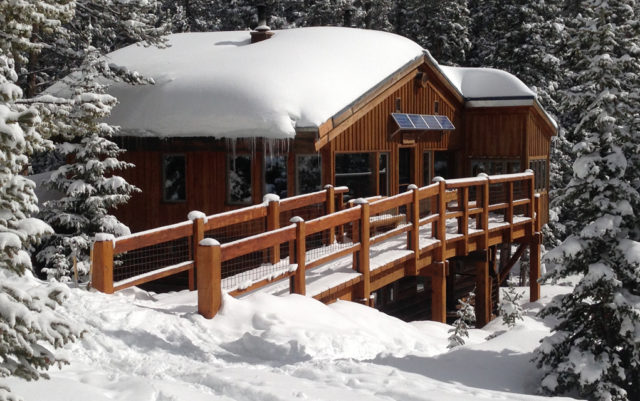
There’s Jackal Hut, Uncle Bud’s Hut and Betty Bear Hut. There’s Skinner and Margy’s, McNamara and Vance’s. All are names of the 34 backcountry huts owned by the 10th Mountain Division Hut Association, the most extensive hut system in Colorado. The nonprofit’s huts provide shelter and simple amenities to skiers, hikers and bikers in the Rocky Mountains.
The huts were inspired by the European hut system American soldiers encountered during World War II. In 1980, veteran Fritz Benedict and others created a nonprofit organization to replicate the huts in the United States. He named it after the 10th Mountain Division — the second mountain warfare unit established by the U.S. Army — of which Benedict had been a member.
In 1941, the day after the Japanese attack on Pearl Harbor, the U.S. Army began training its first mountain troops to prepare for the snowy, alpine terrain in Italy.
Based in Washington state, just south of Tacoma, the 87th Mountain Infantry Battalion trained in intense conditions, including on Mount Rainier. The National Ski Patrol aided in recruitment for this division, reaching out to universities and ski clubs for qualified, experienced skiers.
Meanwhile, another garrison was built outside Leadville. At an elevation of 9,200 feet, Camp Hale became the base for the 10th Light Division (Alpine) in July of 1943. A year later, it was renamed as the 10th Mountain Division. (In 1945, the division moved to Camp Swift in Texas.)
While stationed at Camp Hale, members were trained in skiing, mountain climbing and survival skills. Members were outfitted in white camouflage gear and taught to drive vehicles that specialized in snow operation.
After training in Colorado and several other locations, the division fought in Italy, enduring the difficulty of both the climate and the war. Amid all this, the soldiers — particularly Benedict — were struck by the comfortable, reliable hut system that sprawled along the mountain routes of Europe.
The 10th Mountain Division Hut Association’s first two huts opened in 1982, and their construction was funded by former Secretary of Defense Robert S. McNamara — an outdoor enthusiast. These two huts were named for him and his wife, Margy.
The following decade, eight more huts were built. There are now 34 huts, some owned and operated by the association, others by private entities or other nonprofits. All are accessible to the public.
There are many other huts and hut divisions in the United States. One of the oldest is the Carter Notch Hut in New Hampshire, which was built in 1904. The Alfred A. Braun Memorial Hut System, established in the 1950s, was Colorado’s first hut system. It consists of seven huts — all near treeline — in the Elk Mountains.
A hut system consists of three or more huts intentionally spaced a day’s walk, bike or ski apart. One can also find hut systems in Oregon, Minnesota, Arkansas and New Mexico (to name a few), but the 10th Mountain Division stands out thanks to its scope, accessibility and history.
The majority of the 10th Mountain Division huts are located between the square formed by the mountain towns of Aspen, Leadville, Vail and Eagle, spaced at intervals along 300 miles of trails. These huts allow for easier and longer outdoor excursions in any season, while also intentionally concentrating backcountry travel to protect the environment from human overuse.
Each hut has its own story, contained within the hut’s logbook. Five of the huts were built to honor soldiers from the 10th Mountain Division who died in World War II. Others are named after those who funded them — the Harry Gates Hut, for instance, was made possible by a donation from the Gates Foundation — named after the late Harry F. Gates, who loved the mountains and was an avid outdoorsman. Jackal hut is the eponymous combination of the names of two 10th Mountain supporters, Jack Schuss and Al Zesiger.
Around three-quarters of the huts’ visitors come in the winter, drawn to the untouched powder and the sudden ease of multi-day trips. The huts ease the difficulty and intensity of winter camping by allowing skiers and snowshoers to travel without the heavy gear necessary for shelters and kitchen supplies.
Amenities such as stoves, pots and pans, water pumps, wood fires, tables and beds allow for lighter travel and a comfortable, warm night’s sleep.
The layout and provisions of each hut vary — some have private rooms, two have running water. They fall into two categories: Self-Service Systems (unstaffed, providing cooking facilities and utensils, outhouses and mattresses), and Full-Service Systems (staffed, providing beds, bathrooms, showers and meals). Some huts are handicap accessible during the summer season.
There is no shortage of activities in Colorado, but few feature a wealth of history quite like the 10th Mountain Division Hut Association. Information, along with winter and summer routes, type of oven (most are wood-burning), and each hut’s availability can be found on huts.org. Reservations can be placed over the phone.














